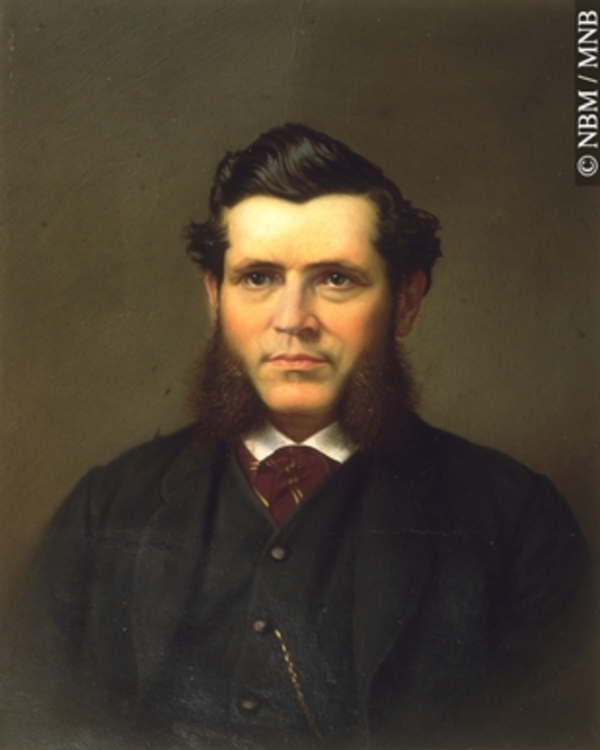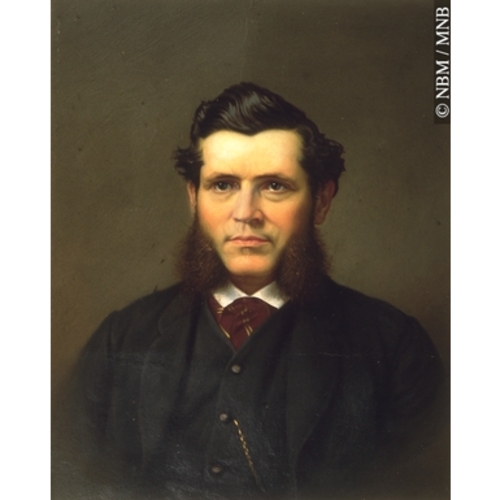
Source: Link
HOLMAN, JAMES HENRY, painter; b. 29 Nov. 1824 in London, or possibly Plymouth Dock (Plymouth), England, eldest son of Samuel Holman and Mary Ann Gover (Grover); d. 27 March 1891 in Boston.
Unable to support himself and his family, in 1827 Samuel Holman decided to leave England, which was then undergoing an economic recession. Persuaded and financially aided by his brother James, a successful merchant in Saint John, N.B., Samuel emigrated to that port; he was followed the next year by his wife and family. Samuel Holman, a house, sign, and ornamental painter, soon established himself in a modestly successful business, and he built a house in the commercial district of the rapidly growing city. His sons were apprenticed to him in the painting trade. Some of the earliest documented pieces of James Henry Holman’s ornamental work are a fresco in the Court House, completed in collaboration with his father in the mid to late 1840s, and ceremonial banners for the masonic fraternity of Saint John, presented in 1859 but unfortunately destroyed in the great fire of 20 June 1877.
In the early 1850s, contradicting his father’s wishes, Holman decided to learn the art of portraiture. Family history tells of his turning the badly lit garret of the family home into a studio and there attempting to acquire the needed skills by painting likenesses while the model held the lamp. His first known portrait, of Vice-Admiral William Fitz William Owen*, was shown at the Amateur Artists’ Exhibition in Saint John in 1856. An early success was a life-size painting of the Prince of Wales, who visited Saint John in 1860. Some citizens were so impressed that they wanted the province to purchase it for the legislative chambers; failing this, they wanted the city to purchase it for the Common Council Room. The history and subsequent location of this work are not known, but it may have been one of the paintings lost in the 1877 fire. Holman’s most unusual work was a commission completed in 1866; the portrait of Robert Jardine*, former president of the European and North American Railway, was painted on a metal plate and affixed to a locomotive engine named in his honour.
Many, if not most, of Holman’s portraits are executed in oil over photographically produced images. This aid to realistic painting was accepted by his contemporaries, the portrait of the Prince of Wales being one of those most highly acclaimed. Between 1865 and 1880 Holman painted the portraits of various family members, friends, and many leading citizens of Saint John. He did not, however, completely abandon decorative painting. In the mid 1870s he was employed in the production of ceremonial banners for various chapters of the Orange lodge, which were in friendly competition to prepare the most elaborate and expensive regalia.
Holman’s career included employment with a number of the photographic firms that existed in Saint John during the period 1860–77. He worked at overpainting photographs in the studios of Bowron and Cox (George J. Bowron and Thomas W. Cox), James R. Woodburn, Woodburn and McClure (James R. Woodburn and James McClure), and James McClure and Company. His success was a result of the public’s desire to have realistic likenesses in naturalistic colour. At the time photography itself was inadequate to the task and skilled artists were needed to colour photographic portraits. Holman’s facility produced some of the best specimens of the genre.
After the 1877 fire, in which most of Saint John’s photographic studios were destroyed, Holman apparently disengaged himself from photography and may have begun to paint from life. He also exhibited work that had been copied from European prints. Unable to prosper in a city in the midst of reconstruction, however, he left Saint John in 1880 or 1881. His entire family having moved to Massachusetts in the 1860s, Holman departed for Boston, where his brother Horatio had worked as a fresco painter until his death in 1874. Holman probably accompanied his former employer James McClure, who left Saint John at the same time. It is possible that while in Boston Holman worked as a painter for one of the subsidiary studios of William Notman’s photographic empire, perhaps at the branch managed by James Notman, William’s younger brother. James had previously operated his own studio in Saint John and Holman’s abilities would have been known to him.
Little else is known of Holman’s career. He died unmarried and childless in Boston in 1891, suffering from alcoholism and intestinal cancer.
Much of Holman’s known work, including a self-portrait, is in the collection of the N.B. Museum, Dept. of Fine and Decorative Arts; other items remain in private collections.
The Church of Jesus Christ of Latter-Day Saints, Geneal. Soc., International geneal. index (Salt Lake City, Utah) indicates that Holman was christened on 18 Dec. 1825 in St Marylebone, London; his place of birth is not given.
N.B. Museum, Dept. of Fine and Decorative Arts, J. H. Holman, artist’s file; Holman Exhibition file, 1959. Stewart, Story of the great fire. Daily Telegraph (Saint John), 16 Sept. 1872; 11 Sept., 5 Oct. 1875; 10, 26 April 1876; 18 Sept. 1879; 30 Jan. 1880. Morning News (Saint John), 15 Oct. 1856; 14 Aug., 27, 30 Sept., 9 Oct. 1861. Canada directory, 1871. Harper, Early painters and engravers. N.B. directory, 1865–66. The St. John and Fredericton business directory, 1862 . . . (Saint John, 1862). Saint John directory, 1863–64, 1869–81. W. F. Bunting, History of St. John’s Lodge, F. & A.M. of Saint John, New Brunswick . . . (Saint John, 1895). D. E. Holman, The Holmans in America . . . (New York, 1909). [G. B. MacBeath], Exhibition of portraits by James Henry Holman, 1821–1891 (exhibition catalogue, N.B. Museum, Dept. of Fine and Decorative Arts, [Saint John, 1959]).
Cite This Article
Peter Larocque, “HOLMAN, JAMES HENRY,” in Dictionary of Canadian Biography, vol. 12, University of Toronto/Université Laval, 2003–, accessed January 10, 2026, https://www.biographi.ca/en/bio/holman_james_henry_12E.html.
The citation above shows the format for footnotes and endnotes according to the Chicago manual of style (16th edition). Information to be used in other citation formats:
| Permalink: | https://www.biographi.ca/en/bio/holman_james_henry_12E.html |
| Author of Article: | Peter Larocque |
| Title of Article: | HOLMAN, JAMES HENRY |
| Publication Name: | Dictionary of Canadian Biography, vol. 12 |
| Publisher: | University of Toronto/Université Laval |
| Year of publication: | 1990 |
| Year of revision: | 1990 |
| Access Date: | January 10, 2026 |



